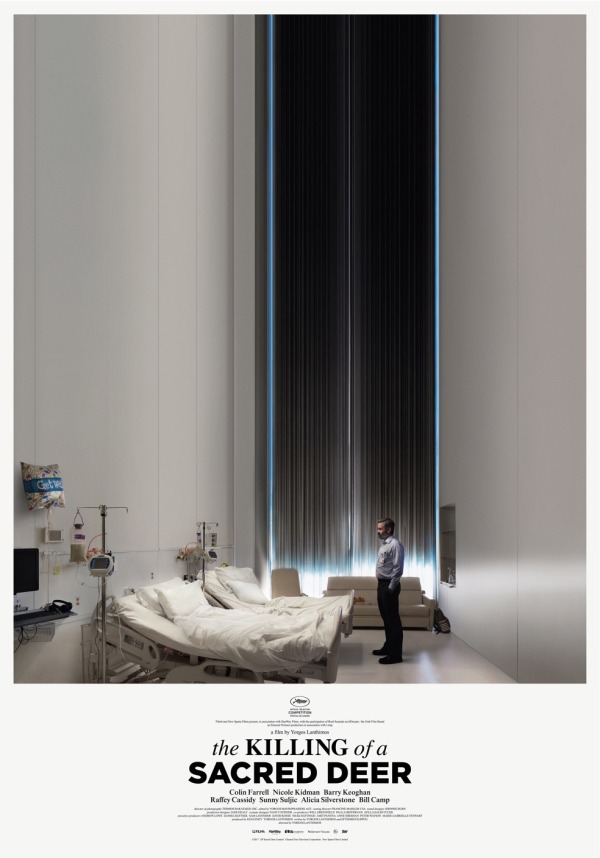THE KILLING OF A SACRED DEER (2017, dir. by Yorgos Lanthimos, 121 min.)
![]() BY DAN BUSKIRK FILM CRITIC The world of computer generated effects has allowed filmmakers a seemingly inexhaustible ability to to create the most audacious worlds imaginable. This week’s release of the latest Thor movie is an example of a colorful multi-hued universe conjured with a level of detail unimaginable in the days when Jack Kirby was first drawing such things in the pages of Marvel comics. Yet despite these tools, the CGI universes created for the big screen are disappointingly similar, showing visions of the future that seem oddly standardized, considering the endless possibilities available.
BY DAN BUSKIRK FILM CRITIC The world of computer generated effects has allowed filmmakers a seemingly inexhaustible ability to to create the most audacious worlds imaginable. This week’s release of the latest Thor movie is an example of a colorful multi-hued universe conjured with a level of detail unimaginable in the days when Jack Kirby was first drawing such things in the pages of Marvel comics. Yet despite these tools, the CGI universes created for the big screen are disappointingly similar, showing visions of the future that seem oddly standardized, considering the endless possibilities available.
This brings us to the films of Yorgos Lanthinos, where nary a special effect is wrought yet something is weirdly “off” in ways we’ve never imagined before. In his 2009 breakthrough Dogtooth that off-kilter world was only as large as one family’s estate, with The Lobster you could see the emotionally-distorted landscape extend across the countryside. With The Killing of the Sacred Deer, Lanthimos’ latest, the insanity is back to being focused on the domestic front, where the tightly-controlled, emotionally-constrained manner of a tidy two-kid household can’t keep the terrors of the outside world from creeping in.
Colin Farrell, who starred in The Lobster, is back for more as Steve, a heart surgeon and the patriarch of the Murphy family, with Nicole Kidman as his icy-calm wife Anna. A quick peek into their sex life shows us that Steve likes it when Anna plays dead. Their daughter Kim’s (Raffey Cassidy) first menstrual cycle gets a deadpan announcement at the dinner table, as well as later, in a casual conversation with Steve and a colleague. Such personal information is dryly offered and dryly received and you’re left to question, “What sort of world of dealing are we with here?”
It’s the conundrum presented to Steve that further defines this twisted world. We see Steve meeting with a very circumspect sixteen year old boy Martin (Dunkirk‘s unnerving Barry Keoghan) and watch the pair as they seem to struggle to make conversation. The odd, furtive interactions between them feels almost sexual but soon the relationship comes into focus: a deadly event has happened between them and Steve is going to have to pay a terrible debt. This is less a threat than a spell that has been cast. Whether fairly or not, fate has locked its sights on Steve and he appears increasingly powerless in escaping its grasp.
Early films by Lanthimos have tempered his pitch black vision with whimsy, from the kids of Dogtooth‘s deathly fear of cats to The Lobster‘s surreal ridiculousness of making first date small talk while trying to avert living life as a crustacean. Amidst the morbidity, there was always a chuckle to be found. Here, a few grim laughs leak out but as the film tightens the screws its seems increasingly likely that Steve is going to have to pay this debt.
Lanthimos stays true to his vision at the climax, although I’m not sure that it makes for a satisfying conclusion as a viewer. The premise, based loosely in the Greek myth of Agamemnon and Artemis, demands blood and Lamthimos really has the deliver to stay true to its own hypothesis. As a writer, Lanthimos delivers the right answer, but he pays a bit of price dramatically. Not that Killing of the Sacred Deer isn’t a fascinating journey, just one that doles out its sad reality with a mathematical efficiency less poetic than inescapable.

